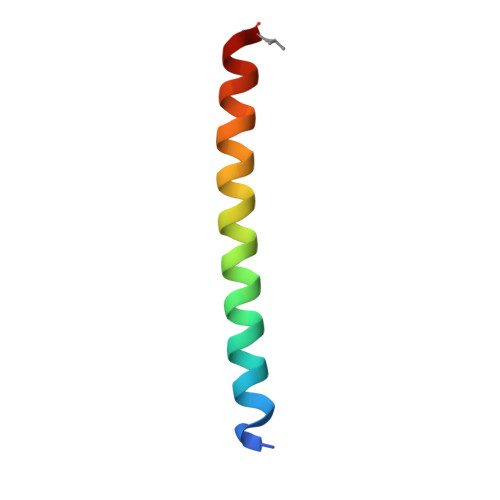Vimentin coil 1A-A molecular switch involved in the initiation of filament elongation.
Meier, M., Padilla, G.P., Herrmann, H., Wedig, T., Hergt, M., Patel, T.R., Stetefeld, J., Aebi, U., Burkhard, P.(2009) J Mol Biol 390: 245-261
- PubMed: 19422834
- DOI: https://doi.org/10.1016/j.jmb.2009.04.067
- Primary Citation of Related Structures:
3G1E - PubMed Abstract:
Interestingly, our previously published structure of the coil 1A fragment of the human intermediate filament protein vimentin turned out to be a monomeric alpha-helical coil instead of the expected dimeric coiled coil. However, the 39-amino-acid-long helix had an intrinsic curvature compatible with a coiled coil. We have now designed four mutants of vimentin coil 1A, modifying key a and d positions in the heptad repeat pattern, with the aim of investigating the molecular criteria that are needed to stabilize a dimeric coiled-coil structure. We have analysed the biophysical properties of the mutants by circular dichroism spectroscopy, analytical ultracentrifugation and X-ray crystallography. All four mutants exhibited an increased stability over the wild type as indicated by a rise in the melting temperature (T(m)). At a concentration of 0.1 mg/ml, the T(m) of the peptide with the single point mutation Y117L increased dramatically by 46 degrees C compared with the wild-type peptide. In general, the introduction of a single stabilizing point mutation at an a or a d position did induce the formation of a stable dimer as demonstrated by sedimentation equilibrium experiments. The dimeric oligomerisation state of the Y117L peptide was furthermore confirmed by X-ray crystallography, which yielded a structure with a genuine coiled-coil geometry. Most notably, when this mutation was introduced into full-length vimentin, filament assembly was completely arrested at the unit-length filament (ULF) level, both in vitro and in cDNA-transfected cultured cells. Therefore, the low propensity of the wild-type coil 1A to form a stable two-stranded coiled coil is most likely a prerequisite for the end-to-end annealing of ULFs into filaments. Accordingly, the coil 1A domains might "switch" from a dimeric alpha-helical coiled coil into a more open structure, thus mediating, within the ULFs, the conformational rearrangements of the tetrameric subunits that are needed for the intermediate filament elongation reaction.
Organizational Affiliation:
Department of Chemistry, University of Manitoba, Winnipeg, Canada. meier@cc.umanitoba.ca














